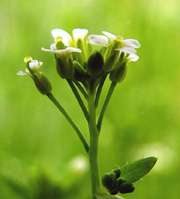Midget plant gets makeover

A tiny plant with a long name (Arabidopsis thaliana) helps researchers from over 120 countries learn how to design new crops to help meet increasing demands for food, biofuels, industrial materials, and new medicines. The genes, proteins, and other traits of this fast-growing, tiny mustard plant reside in a vast database dubbed the Arabidopsis Information Resource (TAIR), which has over 1.6 million page hits each month. The TAIR group, headed by Dr. Eva Huala at Carnegie's Department of Plant Biology, just released a new version of the genome sequence of this model plant, which includes an array of improvements and novel features that promise to accelerate this critical research.
The new TAIR9 genome release contains detailed information on all 33,518 genes that make up this tiny plant (including 114 newly discovered genes and 168 new pseudogenes), the proteins produced by these genes, and extensive new experimental and computationally predicted gene-function information.
Huala highlighted the advances: "We now have a ranking system that provides a measure of our confidence that the structure of a specific gene is correct; we've overhauled information on pseudogenes—the evolutionary remnants that start out as copies of conventional protein-coding genes and sometimes take on interesting new functions; and we've made extensive updates to the genome sequence based on new sequence data submitted to TAIR."
In 2000, Arabidopsis was the first plant genome to be sequenced. Partly due to the vast experimental data on gene function, which TAIR has painstakingly extracted from the literature and associated to the genes, and because of an extensive set of molecular tools developed for this plant, the Arabidopsis genome is the most advanced plant genome in the world and is the most commonly used experimental plant today. Its small size and fast growth allow large-scale experiments on drought and salt tolerance, resistance to plant diseases, and other topics with a direct impact on economic and food quality issues to be carried out quickly and economically, and the results applied to important crop species.
"TAIR is a crucial resource for plant sciences, but its impact goes far beyond," remarked Dr. Wolf Frommer, director of Carnegie's Department of Plant Biology. "TAIR9, as the 'green' reference database, is crucial for understanding the function and engineering of algae as well as crop plants. It is the basis for all improvement of crop plants to meet the challenges of a growing population as well as climate change."
Source: Carnegie Institution
















